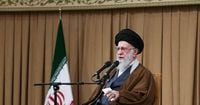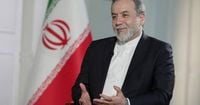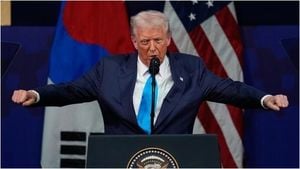For the past 18 months, Iran has found itself battered by a series of strategic setbacks, each compounding the challenges facing the Islamic Republic on the world stage. The downward spiral began with the Biden Administration’s successful defense of Israel against two bold Iranian missile attacks, followed by the weakening of Hezbollah, the collapse of the Assad regime, and the devastation wrought by a 12-day war that left scars across the region. Most recently, on September 27, the so-called E3—Britain, France, and Germany—implemented the snapback mechanism, reimposing United Nations sanctions that had been lifted under the 2015 Iran nuclear deal. According to a detailed policy memo reviewed by Foreign Affairs, these developments have left Iran both weakened and, paradoxically, perhaps more dangerous than ever.
Despite the operational successes claimed by Israel and its Western allies, Iran still retains significant nuclear capabilities. Senior American and Israeli officials now acknowledge that Iran possesses large quantities of highly enriched uranium and advanced centrifuges, all without the oversight of the International Atomic Energy Agency (IAEA). This lack of transparency has only heightened nuclear anxieties, especially as domestic calls within Iran for a nuclear breakout have grown louder in the wake of recent conflicts. The technical expertise and knowledge that Iran has amassed since President Trump withdrew from the Joint Comprehensive Plan of Action (JCPOA) in 2018 continue to pose a formidable challenge to nonproliferation efforts.
The 12-day war, which erupted after Israeli strikes on Iranian nuclear facilities in June 2025, was particularly costly. As reported by Al Jazeera and Foreign Affairs, more than 900 Iranians and 28 Israelis lost their lives—many of them civilians. Thousands more were injured or displaced, and the physical toll was staggering: around 240 buildings and over 2,000 homes in Israel were damaged or destroyed by retaliatory Iranian strikes. The war also left Iran’s nuclear program battered but not broken; the Defense Intelligence Agency estimated that the strikes set back Iran’s nuclear ambitions by only a few months.
With no written or agreed-upon ceasefire in place as of early November 2025, both Iran and Israel are reportedly preparing for a second, potentially more intense round of conflict. Israeli officials, speaking privately, now refer to the 12-day war as “the first Iran war,” convinced that a new round will more aggressively target Iran’s missile program and the regime itself. For its part, Iran is unlikely to be caught off guard again. The cycle of escalation appears poised to continue, with hawkish voices in both countries—and in the United States—arguing for renewed military action.
Yet, amid this tense standoff, diplomatic efforts have stalled. Iranian Foreign Minister Abbas Araghchi told Al Jazeera on November 3, 2025, that Iran is “not in a hurry” to resume nuclear talks with the United States. Araghchi left the door open for indirect negotiations, but only if Washington approaches the table “from an equal position based on mutual interest.” He dismissed reported US conditions for talks—including zero uranium enrichment, strict limits on Iran’s missile stocks, and an end to support for regional allies—as “illogical and unfair.” “It appears they are not in a hurry,” Araghchi said. “We are not in a hurry, either.”
Iran’s position is shaped not only by external pressures but also by shifting regional dynamics. Araghchi noted a growing “shared understanding” in the Middle East regarding Israel, suggesting that attitudes toward the Jewish state are hardening across the region. In a striking development, Oman’s Foreign Minister Badr bin Hamad al-Busaidi publicly criticized Israeli policies at the IISS Manama Dialogue 2025, declaring, “We have long known that Israel, not Iran, is the primary source of insecurity in the region.” Oman, often a mediator between Iran and the West, signaled that the Gulf Cooperation Council’s (GCC) historic posture of isolating Iran “needs to change.”
Diplomatic channels remain open, if tenuously. Tehran confirmed it had received a new message from President Trump’s administration via Oman, but the content and Iran’s response remain undisclosed. While France, the United Kingdom, and Germany have expressed a desire to restart talks with Tehran, no substantial progress has been made. Instead, the E3 recently imposed new sanctions and suspended bilateral air services agreements with Iran, affecting carriers like Iran Air. However, there are signs of a cautious thaw: Austrian Airlines has resumed flights to Tehran, and Germany’s Lufthansa is scheduled to follow suit.
Meanwhile, Iran’s nuclear program remains a source of international anxiety. Araghchi revealed that almost all of the approximately 400 kilograms of 60-percent enriched uranium in Iran’s possession is “buried under the rubble” of bombed facilities. “We have no intention of removing them from under the rubble until conditions are ready. We have no information on how much of the 400kg is untouched and how much is destroyed, and we will have no information until we dig them out,” he said. This admission highlights the uncertainty and opacity surrounding Iran’s nuclear status, especially in the absence of IAEA oversight.
Complicating matters further, China and Russia have formally announced that they do not recognize the UN sanctions reimposed by the E3. This divergence among global powers underscores the complexity of forging a unified international response to Iran’s nuclear ambitions. The United States and its European allies face a dilemma: how to apply enough pressure to bring Iran back to the negotiating table without provoking further escalation or pushing Tehran closer to nuclear breakout.
The consequences of the Trump Administration’s 2018 withdrawal from the JCPOA continue to reverberate. Before the 12-day war, Iran’s breakout time—the period needed to produce enough nuclear fuel for a bomb—had shrunk from one year under the JCPOA to less than two weeks. According to Foreign Affairs, Iran could produce enough material for five to six bombs in that window. While military strikes have temporarily slowed Iran’s progress, they have not eliminated the threat. Instead, the region has been left more unstable, with civilian casualties mounting and the risk of broader conflict increasing.
Looking ahead, any new agreement will have to account for Iran’s advances in nuclear technology, its missile program, and its support for regional proxies. The memo reviewed by Foreign Affairs suggests that new partners, such as the Gulf Cooperation Council states, should be included in future talks. The Gulf States themselves have shifted from confrontation to engagement with Iran, prioritizing economic growth and diversification. This trend could provide a foundation for renewed diplomacy—if the political will exists.
Ultimately, the memo warns that further military escalation is a dangerous and costly path. Diplomacy, not force, offers the only sustainable solution to the Iran problem. The most urgent priority now is to prevent fighting from restarting and to reestablish international oversight of Iran’s nuclear program. As President Trump has repeatedly campaigned on ending “stupid forever wars,” his administration faces a critical test: can it resist the calls for renewed conflict and instead pursue a diplomatic resolution that enhances US and regional security?
For now, the fate of Iran’s nuclear program—and the stability of the wider Middle East—hangs in the balance, with the world watching closely for signs of either renewed conflict or an elusive diplomatic breakthrough.





